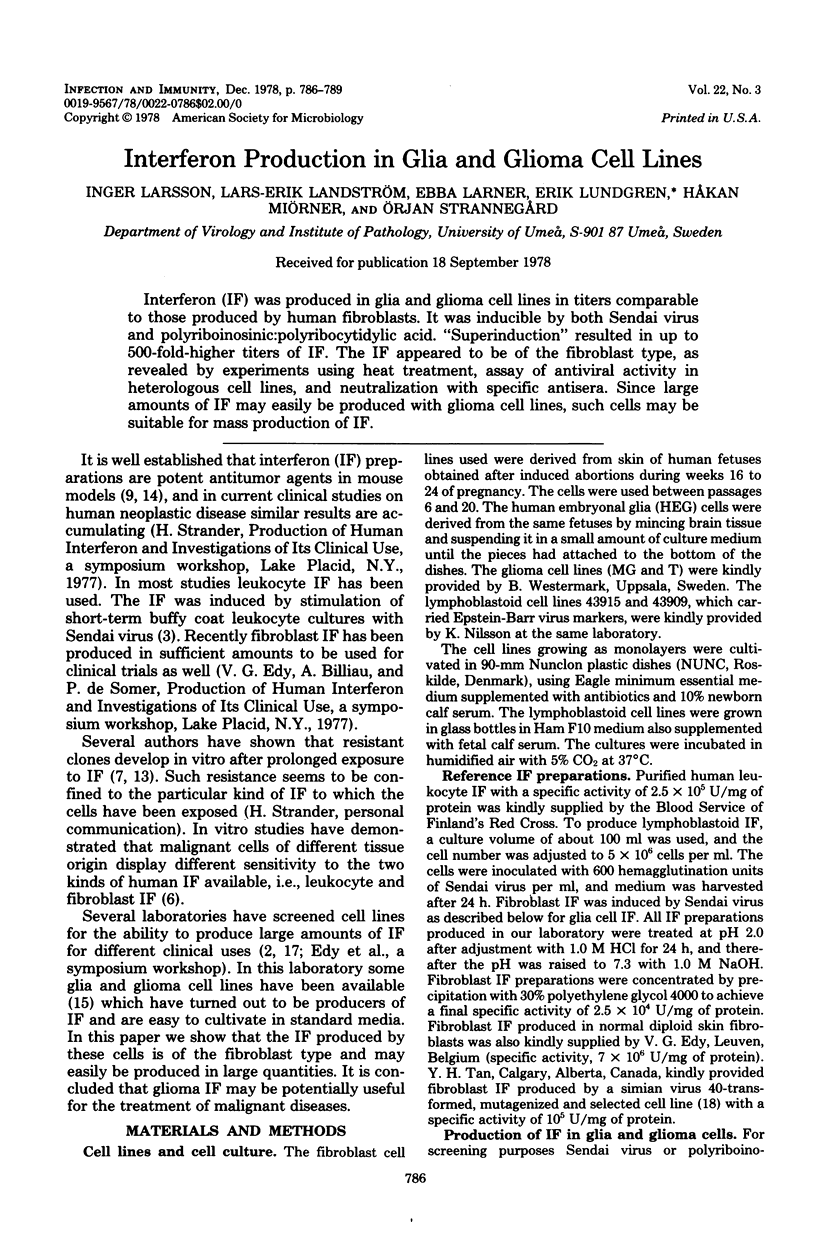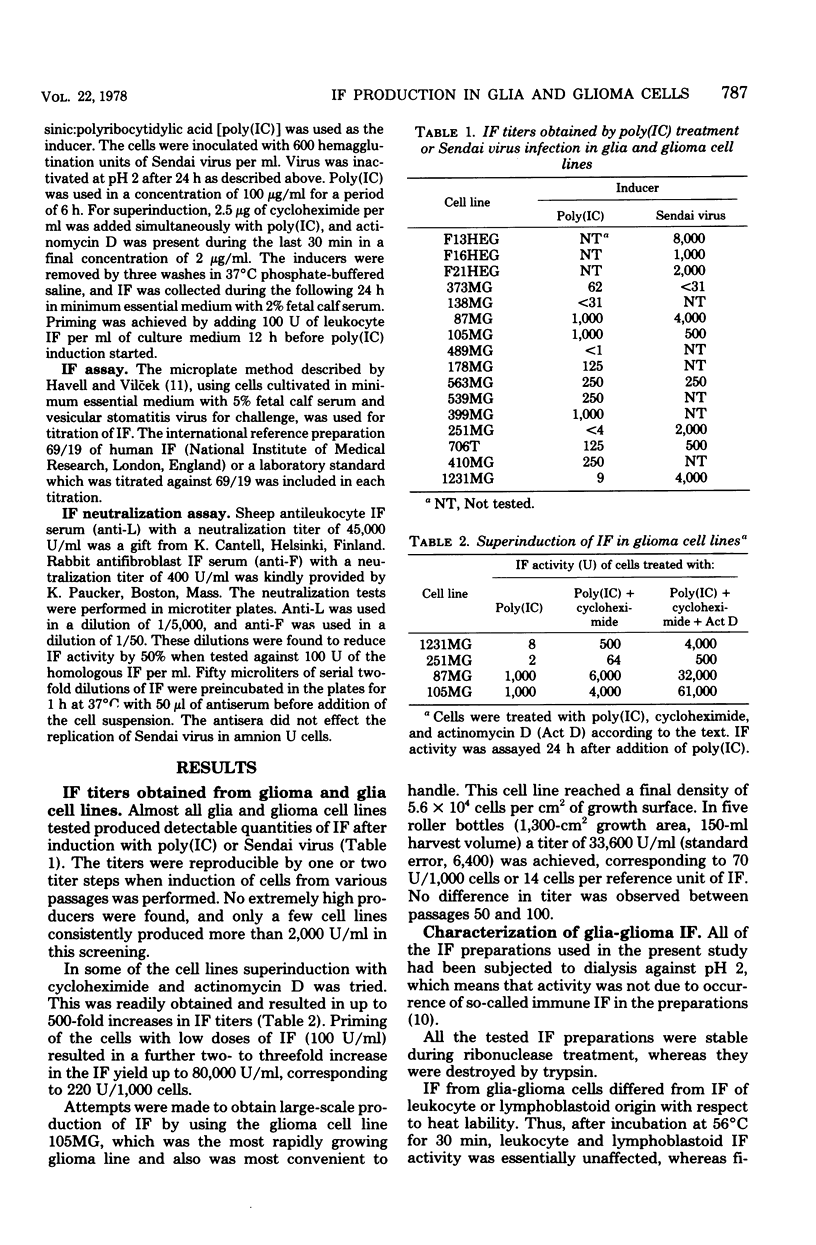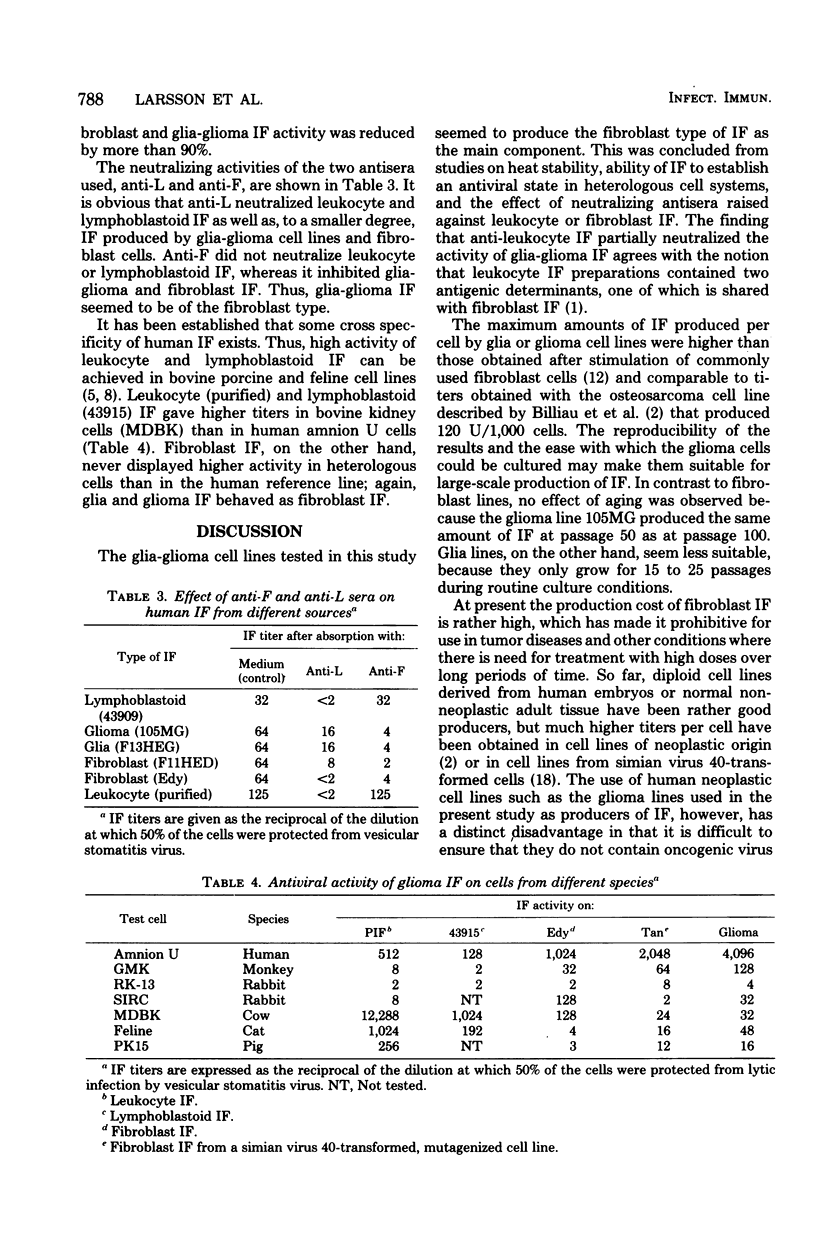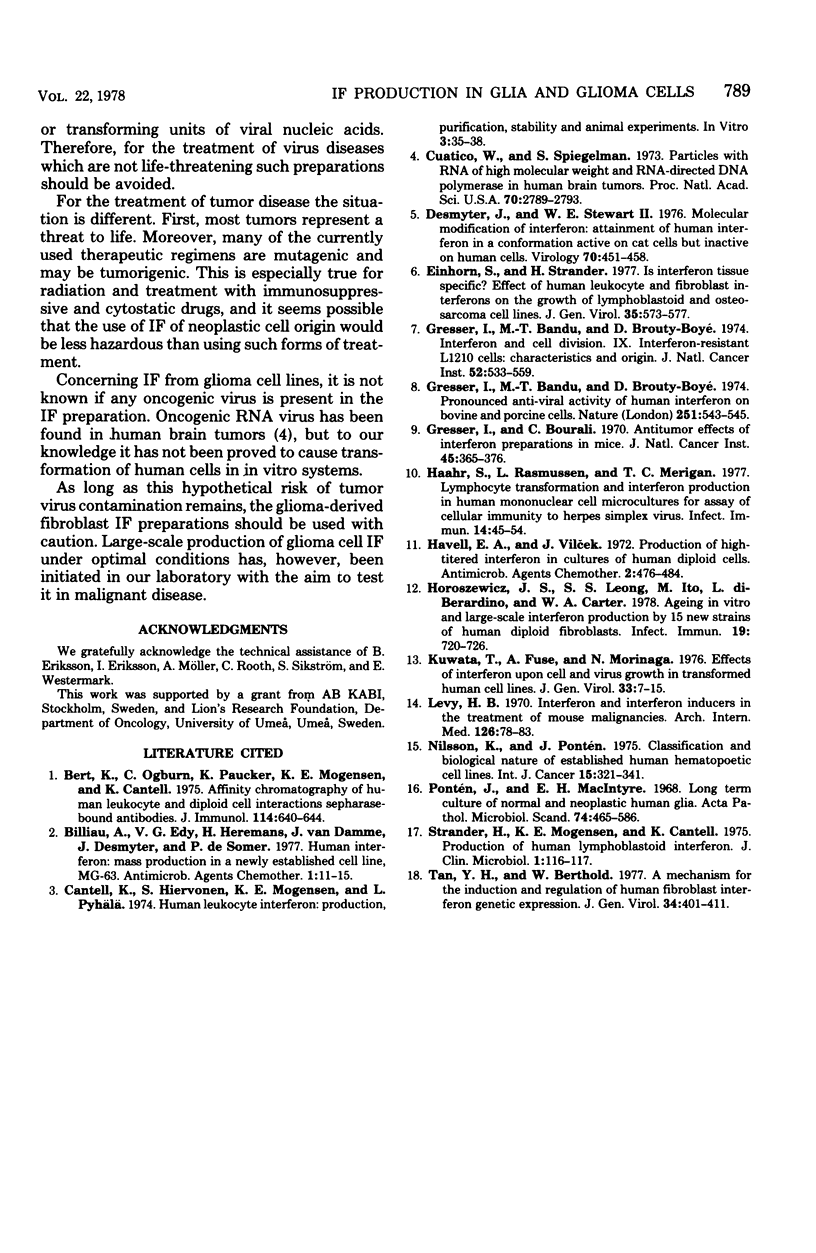Abstract
Interferon (IF) was produced in glia and glioma cell lines in titers comparable to those produced by human fibroblasts. It was inducible by both Sendai virus and polyriboinosinic:polyribocytidylic acid. "Superinduction" resulted in up to 500-fold-higher titers of IF. The IF appeared to be of the fibroblast type, as revealed by experiments using heat treatment, assay of antiviral activity in heterologous cell lines, and neutralization with specific antisera. Since large amounts of IF may easily be produced with glioma cell lines, such cells may be suitable for mass production of IF.
Full text
PDF



Selected References
These references are in PubMed. This may not be the complete list of references from this article.
- Berg K., Ogburn C. A., Paucker K., Mogensen K. E., Cantell K. Affinity chromatography of human leukocyte and diploid cell interferons on sepharose-bound antibodies. J Immunol. 1975 Feb;114(2 Pt 1):640–644. [PubMed] [Google Scholar]
- Billiau A., Edy V. G., Heremans H., Van Damme J., Desmyter J., Georgiades J. A., De Somer P. Human interferon: mass production in a newly established cell line, MG-63. Antimicrob Agents Chemother. 1977 Jul;12(1):11–15. doi: 10.1128/aac.12.1.11. [DOI] [PMC free article] [PubMed] [Google Scholar]
- Cantell K., Hirvonen S., Mogensen K. E., Pyhälä L. Human leukocyte interferon: production, purification, stability, and animal experiments. In Vitro Monogr. 1974;(3):35–38. [PubMed] [Google Scholar]
- Cuatico W., Cho J. R., Spiegelman S. Particles with RNA of high molecular weight and RNA-directed DNA polymerase in human brain tumors. Proc Natl Acad Sci U S A. 1973 Oct;70(10):2789–2793. doi: 10.1073/pnas.70.10.2789. [DOI] [PMC free article] [PubMed] [Google Scholar]
- Desmyter J., Stewart W. E., 2nd Molecular modification of interferon: attainment of human interferon in a conformation active on cat cells but inactive on human cells. Virology. 1976 Apr;70(2):451–458. doi: 10.1016/0042-6822(76)90286-5. [DOI] [PubMed] [Google Scholar]
- Einhorn S., Strander H. Is interferon tissue specific?- Effect of human leukocyte and fibroblast interferons on the growth of lymphoblastoid and osteosarcoma cell lines. J Gen Virol. 1977 Jun;35(3):573–577. doi: 10.1099/0022-1317-35-3-573. [DOI] [PubMed] [Google Scholar]
- Fuse T. K., Morinaga N. Effects of interferon on cell and virus growth in transformed human cell lines. J Gen Virol. 1976 Oct;33(1):7–15. doi: 10.1099/0022-1317-33-1-7. [DOI] [PubMed] [Google Scholar]
- Gresser I., Bandu M. T., Brouty-Boyé D. Interferon and cell division. IX. Interferon-resistant L1210 cells: characteristics and origin. J Natl Cancer Inst. 1974 Feb;52(2):553–559. doi: 10.1093/jnci/52.2.553. [DOI] [PubMed] [Google Scholar]
- Gresser I., Bandu M. T., Brouty-boye D., Tovey M. Pronounced antiviral activity of human interferon on bovine and porcine cells. Nature. 1974 Oct 11;251(5475):543–545. doi: 10.1038/251543a0. [DOI] [PubMed] [Google Scholar]
- Gresser I., Bourali C. Antitumor effects of interferon preparations in mice. J Natl Cancer Inst. 1970 Aug;45(2):365–376. [PubMed] [Google Scholar]
- Haahr S., Rasmussen L., Merigan T. C. Lymphocyte transformation and interferon production in human mononuclear cell microcultures for assay of cellular immunity to herpes simplex virus. Infect Immun. 1976 Jul;14(1):47–54. doi: 10.1128/iai.14.1.47-54.1976. [DOI] [PMC free article] [PubMed] [Google Scholar]
- Havell E. A., Vilcek J. Production of high-titered interferon in cultures of human diploid cells. Antimicrob Agents Chemother. 1972 Dec;2(6):476–484. doi: 10.1128/aac.2.6.476. [DOI] [PMC free article] [PubMed] [Google Scholar]
- Horoszewicz J. S., Leong S. S., Ito M., Di Berardino L., Carter W. A. Aging in vitro and large-scale interferon production by 15 new strains of human diploid fibroblasts. Infect Immun. 1978 Feb;19(2):720–726. doi: 10.1128/iai.19.2.720-726.1978. [DOI] [PMC free article] [PubMed] [Google Scholar]
- Levy H. B. Interferon and interferon inducers in the treatment of malignancies. Arch Intern Med. 1970 Jul;126(1):78–83. [PubMed] [Google Scholar]
- Nilsson K., Pontén J. Classification and biological nature of established human hematopoietic cell lines. Int J Cancer. 1975 Feb 15;15(2):321–341. doi: 10.1002/ijc.2910150217. [DOI] [PubMed] [Google Scholar]
- Pontén J., Macintyre E. H. Long term culture of normal and neoplastic human glia. Acta Pathol Microbiol Scand. 1968;74(4):465–486. doi: 10.1111/j.1699-0463.1968.tb03502.x. [DOI] [PubMed] [Google Scholar]
- Strander H., Mogensen K. E., Cantell K. Production of human lymphoblastoid interferon. J Clin Microbiol. 1975 Jan;1(1):116–117. doi: 10.1128/jcm.1.1.116-117.1975. [DOI] [PMC free article] [PubMed] [Google Scholar]
- Tan Y. H., Berthold W. A mechanism for the induction and regulation of human fibroblastoid interferon genetic expression. J Gen Virol. 1977 Mar;34(3):401–411. doi: 10.1099/0022-1317-34-3-401. [DOI] [PubMed] [Google Scholar]


